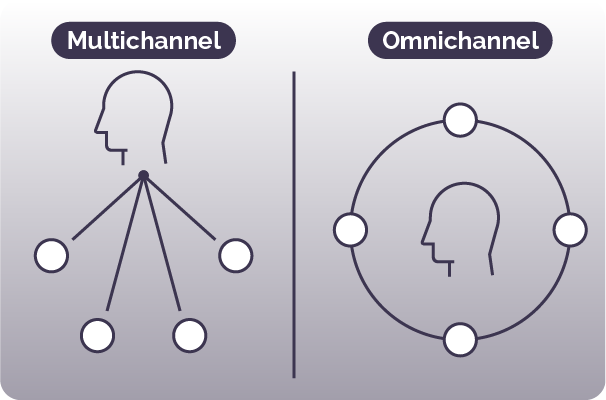As companies strive to engage customers across all platforms, transitioning from multichannel to omnichannel strategies is becoming a new norm for business success. Omnichannel marketing aims to provide a seamless experience across touchpoints, both online and offline, enabling customers to switch between the two channels smoothly. This approach allows businesses to reach them through the most convenient means, where they are, by gaining valuable insights into customers' preferences and adjusting their services accordingly.
By adopting an omnichannel marketing strategy, businesses can guarantee a consistent, top-notch customer experience, regardless of their preferred mode of interaction. Through a deeper comprehension of customer preferences, companies can personalize their interactions, which boosts engagement and customer satisfaction.
What is Multichannel Marketing?
Multichannel marketing refers to an approach that involves the use of multiple channels or communication modes to reach and interact with customers.
In the context of digital marketing, a multichannel approach typically involves using various channels, such as social media, search engines, mobile apps, and other digital and traditional channels, to promote products or services, engage with customers, and drive sales.
For example, a business might independently run social media campaigns, Paid Media, and email marketing without connecting these efforts, allowing each to operate as a standalone strategy.
Overall, the use of a multichannel marketing approach can help organizations reach a wider audience, enhance the customer experience, and improve the effectiveness of their communication and marketing efforts.
What is Omnichannel Marketing?
An omnichannel marketing strategy aims to provide customers with a seamless and consistent experience across all channels and touchpoints, including online, mobile, social media, brick-and-mortar stores, and other physical locations.
The term “omnichannel” emphasizes the need for businesses to integrate all their channels and provide a cohesive customer experience, rather than treating each channel in isolation.
An effective omnichannel marketing strategy requires businesses to collect data on customer behavior and preferences from all channels and use that data to personalize the customer experience. For instance, a customer who browses a product online and then visits a physical store to make a purchase should be able to seamlessly pick up where they left off and complete their purchase without any hassle.
In this example, a customer could browse a product on a retailer’s website, receive a personalized email reminder, and then seamlessly complete the purchase in store, where the business has access to their browsing history and preferences.
The goal of an omnichannel digital marketing approach is to make it easy for customers to interact with a business and to provide a consistent and enjoyable experience, regardless of the channel they choose. By doing so, companies can improve customer loyalty and increase sales.
Leveraging tools like CRM systems or automation platforms ensures businesses can effectively manage integrated channels and maintain a personalized, streamlined customer experience.
Multichannel vs. Omnichannel: Why Shift?
Multichannel marketing and omnichannel marketing are two different approaches to customer experience and marketing strategies.
As discussed above, multichannel marketing refers to having multiple channels of communication or touchpoints with customers. These channels may operate independently of each other, and customers might have different experiences depending on the channels they choose to use.
On the other hand, omnichannel marketing focuses on creating a seamless and integrated customer experience across all channels. This means that all touchpoints are connected, and customers can move between them without any interruption or loss of information. For instance, a customer could start their journey on a mobile app, continue it on a website, and finish in store, all with a personalized experience. Omnichannel strategies leverage data and technology to create a cohesive experience across all channels, including online and offline interactions.
There's been a shift towards omnichannel strategies because consumers now expect a consistent experience across all channels. With the rise of digital channels, customers have more options for engaging with brands. They expect a seamless and integrated journey across all touchpoints, leading to increased customer loyalty, higher sales, and improved customer satisfaction.
In the end, the shift towards omnichannel marketing makes sense for most brands, as consumers now expect a consistent experience across all channels. With the increase of digital marketing channels, consumers have more options for engaging with brands, and they expect a seamless and integrated experience.
How to Shift to Omnichannel Marketing from Multichannel Marketing
Shifting from multichannel marketing to omnichannel marketing involves a more integrated approach to your marketing efforts, which aims to provide a seamless and consistent customer experience throughout a buyer's journey. Here are some steps to help you transition:
1. Analyze your Current Marketing Channels
Start by analyzing your existing online marketing channels to determine which are most effective in reaching your target audience. As you look at examples of multichannel marketing, step into the shoes of your consumers and figure out where things are clunky or frustrating — that's what you want to avoid!
2. Identify your Customer Touchpoints
Now it's time to identify all the touchpoints where your customers interact with your brand across channels. Your omnichannel processes should include a peeled-back-curtain approach to all things related to email, social media, mobile apps, and in-store experiences. You need to know who you're talking to and what they're looking for.
3. Develop a Cohesive Message
Create a consistent message that'll be communicated across all channels to provide a unified customer experience, no matter where people find your brand. Multichannel distribution can be useful in some ways, but it's often a clunky transition from one platform to the next. Omnichannel marketing helps smooth out this process.
4. Use Data to Personalize Experiences
Collect data on customer interactions and use it to personalize their experiences with your brand. Take, for example, a customer who purchases a product online; you could offer them a personalized coupon for their next in-store purchase once that deal is done.
5. Integrate your Marketing Channels
Ensure all your marketing channels are connected and integrated to provide a seamless experience for your audience. Think about it – customers should be able to access their shopping carts on your website and from their mobile app.
6. Invest in Technology
Use technology to streamline your omnichannel marketing efforts, such as a CRM system that allows you to track customer interactions across channels.
7. Continuously Test and Refine
Keep testing and refining your omnichannel marketing strategy to optimize your results.
Speak with Omnichannel Agency Experts at ZGM
Are you still stuck in a multichannel mindset? It's time to make the shift to omnichannel. Reach out to the omnichannel marketing agency experts at ZGM today!
About the Author














